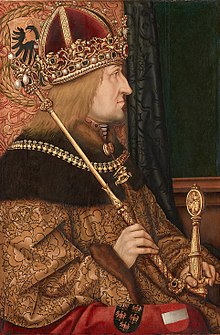
Back Friedrich III. (HRR) ALS فريدريك الثالث Arabic فريدريك التالت ARZ Federico III d'Habsburgu AST اۆچونجو فریدریش (ایمپیراتور) AZB Фридрих III (Изге Рим империяһы императоры) Bashkir Фрыдрых III Габсбург Byelorussian Фридрих III (Свещена Римска империя) Bulgarian Friedrich III an Impalaeriezh Santel Breton Fridrik III, car Svetog Rimskog Carstva BS
| Frederick III | |
|---|---|
 Portrait by Hans Burgkmair, c. 1500 | |
| Reign | 19 March 1452 – 19 August 1493 |
| Coronation | 19 March 1452 |
| Predecessor | Sigismund |
| Successor | Maximilian I |
| King of Germany | |
| Reign | 2 February 1440 – 19 August 1493 |
| Coronation | 17 June 1442 |
| Predecessor | Albert II |
| Successor | Maximilian I |
| Alongside | Maximilian I (1486–1493) |
| Archduke of Austria | |
| Reign | 23 November 1457 – 19 August 1493 |
| Predecessor | Ladislaus |
| Successor | Maximilian I |
| Alongside | Albert VI (1457–1463) |
| Duke of Styria, Carinthia and Carniola (Inner Austria) | |
| Reign | 10 June 1424 – 19 August 1493 |
| Predecessor | Ernest |
| Successor | Maximilian I |
| Alongside | Albert VI (1424–1463) |
| Born | 21 September 1415 Innsbruck, Tyrol |
| Died | 19 August 1493 (aged 77) Linz, Austria |
| Burial | |
| Spouse | |
| Issue more... | |
| House | Habsburg |
| Father | Ernest, Duke of Austria |
| Mother | Cymburgis of Masovia |
Frederick III (German: Friedrich III, 21 September 1415 – 19 August 1493) was Holy Roman Emperor from 1452 until his death in 1493. He was the penultimate emperor to be crowned by the pope, and the last to be crowned in Rome.
Prior to his imperial coronation, he was duke of the Inner Austrian lands of Styria, Carinthia and Carniola from 1424, and also acted as regent over the Duchy of Austria from 1439. He was elected and crowned King of Germany in 1440.[1] His reign of 53 years is the longest in the history of the Holy Roman Empire or the German monarchy. Upon his death in 1493 he was succeeded by his son Maximilian.
During his reign, Frederick concentrated on re-uniting the Habsburg "hereditary lands" of Austria and took a lesser interest in Imperial affairs. Nevertheless, by his dynastic entitlement to Hungary as well as by the Burgundian inheritance, he laid the foundations for the later Habsburg Empire. Despite being mocked as "Arch-Sleepyhead of the Holy Roman Empire" (German: Erzschlafmütze) during his lifetime,[2] he is today increasingly seen as an effective ruler.
Historian Thomas A. Brady Jr. credited Frederick with leaving a credible claim on the imperial title and a secure grip on the Austrian lands, now organized as a single state, for his son. This imperial revival (as well as the rise of the territorial state) began under the reign of Frederick.[3]
- ^ He was the fourth Frederick to rule Germany in the Habsburgs' preferred enumeration, which counted Frederick the Fair ("Frederick III") as a legitimate king, although he was elected by only a minority of electors. Cf. Anthony Radcliffe (1986), "The Habsburg Images: Cigoli, Terzio and Reichle", The Burlington Magazine, 128 (995), 103–06.
- ^ Curtis, Benjamin (2013). The Habsburgs: The History of a Dynasty. Bloomsbury. p. 36.
- ^ Brady, Thomas A. Jr. (13 July 2009). German Histories in the Age of Reformations, 1400–1650. Cambridge University Press. pp. 104–106, 116. ISBN 978-1-139-48115-1. Retrieved 21 January 2022.
© MMXXIII Rich X Search. We shall prevail. All rights reserved. Rich X Search